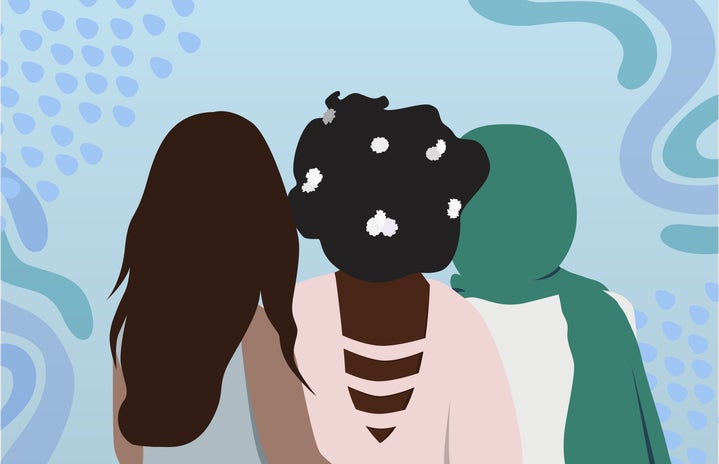My best friend throughout high school was a bright and bubbly person. She always knew how to cheer you up, would listen to your stories, and understood what you liked and disliked. She was a straight-A student who loved and understood math. If you needed help with your homework or did not know an equation to a math problem, she was always there to help.
However, something in her changed during high school. Instead of not caring about what other people thought as she had done in previous years, she became hyper-aware of her surroundings. She was trying to be the prettiest and most popular girl in the school. Rather than bringing out that vivacious personality of hers, she kept it locked away in a deep vault. She was scared to let people see who she truly was and worried about others’ opinions. She had been told that she was too “out there” and annoying. This hurt her mentally, and it physically exhausted her.
These tendencies to try and be the prettiest and the most popular girl in school are not uncommon in American society. In fact, it is heavily embraced in cultures like that of a “Nuclear Family.” This idea is spread through coming-of-age movies, social media, and books. However, my friend felt like she was struggling to keep up with these high school stereotypes.
After months of struggling to be her true self and not understanding why she wasn’t “normal,” she finally decided to get physiologically tested. At age eighteen, she expected that she would be diagnosed with attention deficit hyperactivity disorder (ADHD) or depression. However, the results stunned her. She was diagnosed with Autism Spectrum Disorder (ASD). She was relieved. My friend finally understood why she felt different than everyone else.
Autism Spectrum Disorder (ASD) is a neurological disorder that affects the way a person interacts in social situations, handles the emotions of other people, and even their own emotions. People with ASD often struggle to recognize body language from others and their body language can be confusing at times (Kroncke et al., 2016). Because of this, conversations with someone who has ASD may be awkward or misleading.
My friend never struggled with holding a conversation. This is where her diagnosis confused her. She could talk for hours about one topic and have a great discussion with the person she was conversing with. How come she did not fit that standard? Was there something wrong with her again?
Her confusion is important because it only shows how limited society is to their knowledge of women who have Autism Spectrum Disorder. My friend, and many other women who have ASD, do not always understand their diagnosis. But why is that? The answer is simple: historical societal standards keep women from understanding their personality and mental state. This, in turn, affects how psychologists diagnose them with disorders, especially ASD. Because of this, there is a continual stigma around women and girls who are on the spectrum.
The Discovery and The Inconsistencies
Autism Spectrum Disorder was discovered by Dr. Leo Kanner in 1943. Before uncovering his research, people with ASD or who were on the spectrum were seen as people with schizophrenia. His studies started with 11 children, 8 boys and 3 girls. In this study, Kanner looked at the past and present habits of these young children. He noticed something similar within these children: they are unable to connect with people in the outside world. Since its discovery in the mid 20th century, the number of cases of people with autism or people who are on the spectrum has risen drastically. This is mainly because according to Murray, more people can recognize Autism Spectrum Disorder in their young children- mainly their young boys .
Why is that? Shortly after the disorder rose into fruition and was reintroduced into society, there became a stigma around it and an assumption that more boys just so happened to have autism. Murray explains that there are many reasons why this happened. One of the main reasons is that the disorder was discovered during a time when women had little to no life outside of the home. Therefore, fewer girls and women were in studies in general .
Women and “Masking”
Women and girls with Autism Spectrum Disorder also “camouflage” their symptoms. This can cause many problems within the psychiatric world. In today’s world, many standards are placed on women whether or not they may be on the spectrum including how they should act, dress, and feel (Castle & Abel, 2016). This makes life harder for people with ASD because, on top of having a social disorder, they are pushed to confine to certain rules because of their gender. Therefore, women and girls with autism feel like they need to hide their disorder to fit in with the rest of the world (Chaplin & Chester, 2019). However, “masking” causes another problem. In general, women are also more likely to read social cues than men. This does not matter if they are autistic or not. Because of this, many women are misdiagnosed with simple attention deficit hyperactivity disorder (ADHD) or anxiety.
Women and Different Interests
Another interesting point that many of the previous researchers bring up is when women are not masking their autism, they express their interests differently than men with ASD. In one instance, boys and men who have autism are more likely to fixate on a physical object like superheroes, trains, or Disney. On the other hand, women and girls with ASD are more interesting and hyperfocus on interests such as their feelings and the feelings of those around them (Chaplin & Chester, 2019). This can cause women and girls to hyper-fixate on other people’s feelings which can be hurtful to their mental health. Many people would call this “obsession” or a simple crush. However, this is another reason why women are misdiagnosed. Their characteristics are similar enough to those of a person without autism and, therefore, they do not receive the proper treatment and diagnosis.
Representation in the Media
Because of setbacks described like the ones above, women with Autism Spectrum Disorder are less likely to be represented accurately in the media. For example, in SIA’s movie Music,a woman with autism was being portrayed, but the actress, Maddie Ziegler, does not have ASD and, therefore, misrepresented autism and the autistic community. Another instance is Disney’s recent cartoon called “Loop”. In this creation, Madison Bandy plays the main character, a girl with ASD. Madison does have autism, unlike previous representations. However, this cartoon only portrays a small portion of women and girls with autism- those who are nonverbal.
One problematic element with the media is that it negatively portrays ASD and influences people to think narrowly about who can and cannot have the disorder. According to Verity Chester, author of “Women, girls, and autism spectrum disorders part I”, it is important to successfully portray autism because it can have “the potential to dispel myths and help improve understanding and knowledge of the experiences of underrepresented groups” (Chaplin & Chester, 2019). Not only does this matter of thinking apply to Autism Spectrum Disorder, but it can also apply to other debilitating disabilities.
Advocating for Women with Autism Spectrum Disorder
My friend decided that she wants to advocate for herself. She joined Distinguished Young Women, a scholarship program formally known as Junior Miss,and had me cheer her on along the way. In that program, she spoke up against the problems with her diagnosis. And, in the end, she placed in the interview category, won the “Miss Congeniality” title, and was named 3rd runner up. She defied every stereotype that was thrown at her and did it all with a smile on her face. She continues to advocate for Autism Spectrum Disorder through social media and in her future career. Although I was with her every step of her journey, she did not need my help whatsoever. She wanted to do something for herself. This, in turn, made her more confident in herself and her abilities- something that all women with ASD should feel empowered to do.
References
Castle, D. J., & Abel, K. M. (Eds.). (2016). Comprehensive Women’s Mental Health. Cambridge University Press. (Available at Seattle Pacific University Library)
Chaplin, E., & Chester, V. (2019). Women, girls, and autism spectrum disorders part I. Emerald Publishing Limited. (https://ebookcentral-proquest-com.ezproxy.spu.edu/lib/spu/reader.action?docID=5752236)
Kroncke, A. P., Willard, M., Huckabee, H., & Reinhardt, J. S. (2016). Assessment of autism spectrum disorder: Critical issues in clinical, forensic, and school settings. Springer. (Available at Seattle Pacific Universitity Library)
Murray, S. (2008). Representing autism. Liverpool University Press. (https://ebookcentral-proquest-com.ezproxy.spu.edu/lib/spu/reader.action?docID=3016892 )


